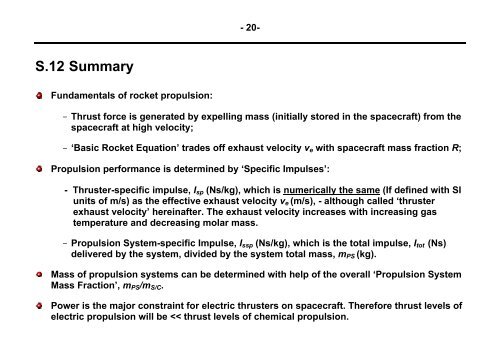S.1 Spacecraft Propulsion Systems Chapter 1: Introduction to ...
S.1 Spacecraft Propulsion Systems Chapter 1: Introduction to ...
S.1 Spacecraft Propulsion Systems Chapter 1: Introduction to ...
You also want an ePaper? Increase the reach of your titles
YUMPU automatically turns print PDFs into web optimized ePapers that Google loves.
<strong>S.1</strong>2 Summary<br />
Fundamentals of rocket propulsion:<br />
- 20-<br />
- Thrust force is generated by expelling mass (initially s<strong>to</strong>red in the spacecraft) from the<br />
spacecraft at high velocity;<br />
- ‘Basic Rocket Equation’ trades off exhaust velocity ve with spacecraft mass fraction R;<br />
<strong>Propulsion</strong> performance is determined by ‘Specific Impulses’:<br />
- Thruster-specific impulse, Isp (Ns/kg), which is numerically the same (If defined with SI<br />
units of m/s) as the effective exhaust velocity ve (m/s), - although called ‘thruster<br />
exhaust velocity’ hereinafter. The exhaust velocity increases with increasing gas<br />
temperature and decreasing molar mass.<br />
- <strong>Propulsion</strong> System-specific Impulse, Issp (Ns/kg), which is the <strong>to</strong>tal impulse, I<strong>to</strong>t (Ns)<br />
delivered by the system, divided by the system <strong>to</strong>tal mass, mPS (kg).<br />
Mass of propulsion systems can be determined with help of the overall ‘<strong>Propulsion</strong> System<br />
Mass Fraction’, mPS/mS/C.<br />
Power is the major constraint for electric thrusters on spacecraft. Therefore thrust levels of<br />
electric propulsion will be


